Hover over images for detail:
 Multiflora rose shrub blooming in June
Multiflora rose shrub blooming in June
Late in spring one recognizes this large shrub in bloom, covered by numerous small white flowers. And like all roses it has serrated edged leaflets — 5 to 9 for this species — and thorns — large, curving, and copious here. Because their red berries ripen in the fall, the best time to tackle this invasive plant is from spring through July.
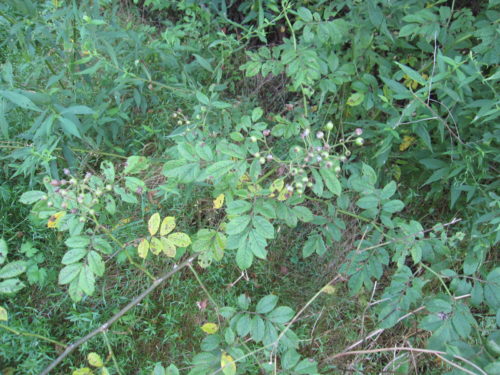 Multiflora rose berries in early August
Multiflora rose berries in early August
Although birds feed on multiflora rose berries, when eaten exclusively these non-native red berries — lacking the high fat content birds need — won’t carry them through the winter. So the best advice is to replace at least some multiflora rose shrubs, which are highly invasive, with native shrubs such as pussy willow (Salix discolor), silky dogwood (Cornus amomum), winterberry holly (Ilex verticillata), elderberry (Sambucus Canadensis) and northern bayberry (Morella [Myrica] pensylvanicato), to provide better nutrition and greater variety. Other alternatives include: coralberry (Symphoricarpos orbiculatus), arrowwood viburnum (Viburnum dentatum), American hazelnut (Corylus americana), and witch hazel (Hamamelis virginiana), which also provide cover for birds in winter.
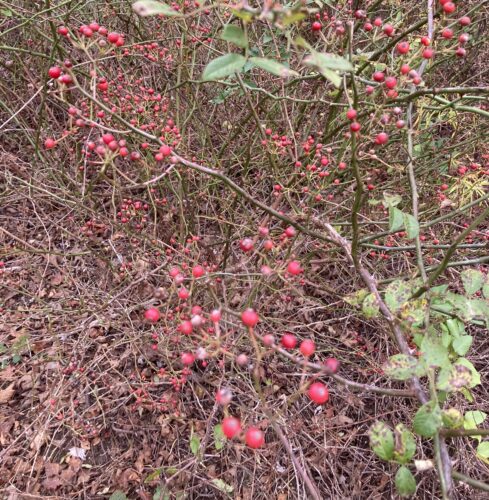 Multiflora rose ripe berries in early November
Multiflora rose ripe berries in early November
Starting in August, be sure to cut and bag multiflora rose berries to prevent their seeds from spreading the plant. The strongest bags to hold and dispose of the thorny briars are empty 50 pound feed bags available from local animal farms, or bags from wild bird grain for bird feeders.
 Large multiflora rose shrub surrounding a maple tree
Large multiflora rose shrub surrounding a maple tree
Multiflora rose can form dense thickets up to six feet high, so when working on it, be sure to wear leather working gloves or even welders’ gloves, goggles or glasses, high boots, long sleeves and long pants. A good trick for shielding one’s body from the thorny canes when cutting them is to lean a large folded carton or sheet of corrugated cardboard against the plant to block the thorny canes.
 Young multiflora rose
Young multiflora rose
Methods for removing multiflora rose vary with the size of the plant, with the objective always being to remove or kill the root crown. Very small seedlings can be pulled with a hand tool, preferably using the gripping power of large 9″ linesman pliers. If cut down without addressing the root crown, this shrub will quickly regrow from suckers.
 Regrowth of new canes
Regrowth of new canes
While large multiflora rose taproots may be too long to dig with a shovel or Pulaski ax without breaking, cutting the canes down to several inches above the ground with loppers or a battery-operated hedge trimmer will allow access to the entire root crown without exposure to the thorns.
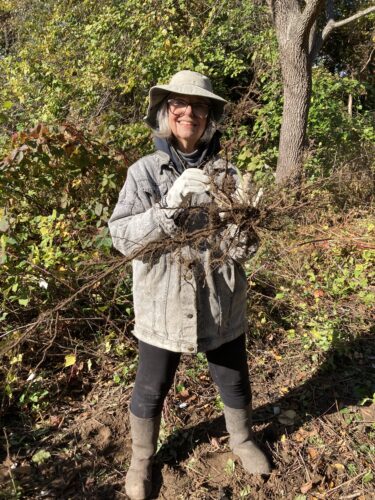 Three-foot taproot pulled with a weed wrench
Three-foot taproot pulled with a weed wrench
If the plant is too large for a shovel or Pulaski ax the best tool is a weed wrench or Pullerbear Tree Puller.
To uproot multiflora rose, cut canes down to the stems roughly 6 inches above the ground, using loppers, a limb saw, or a reciprocating saw with a limb saw blade. This works for the time being, leaving enough stem to uproot by hand or for the weed wrench or pullerbear to grab/uproot immediately or later when the ground is moist.
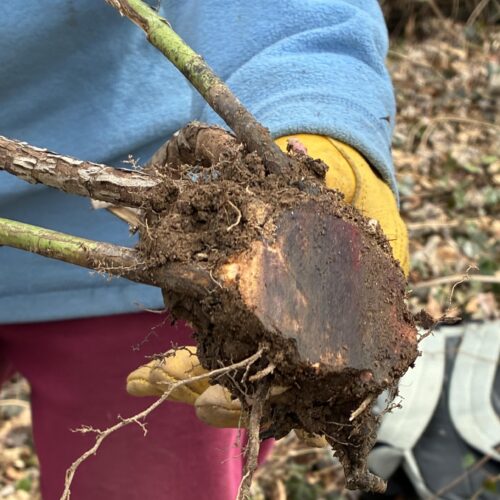
While large multiflora rose taproots may be too long to pull or dig with a shovel or Pulaski ax without breaking, cutting the canes down to several inches above the ground with loppers or a battery-operated hedge trimmer will allow access to the entire root crown without exposure to the thorns. Sever the root crown along the ground using a reciprocating saw with a limb saw blade.
Reminder: when working with multiflora rose, always wear thick leather work gloves or welder’s gloves.
Methods and tools to help eliminate large multiflora rose shubs:
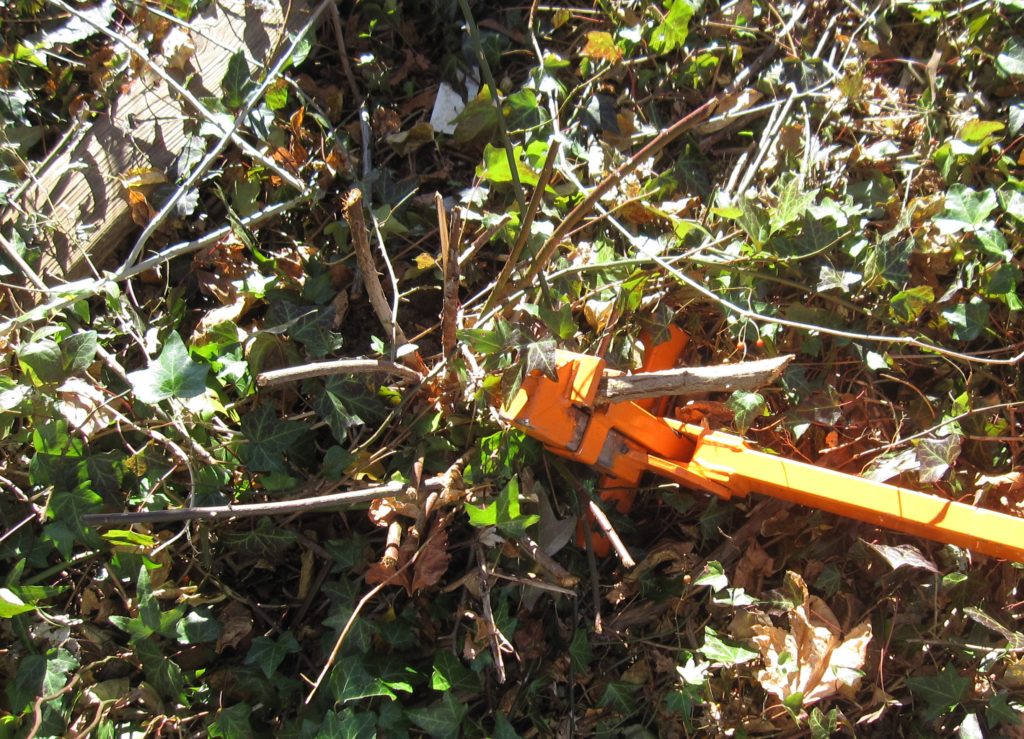 Weed wrench grabs stump
Weed wrench grabs stump
While a weed wrench is the preferred tool, especially when the soil is damp, using other tools may be sufficient to prevent regrowth.
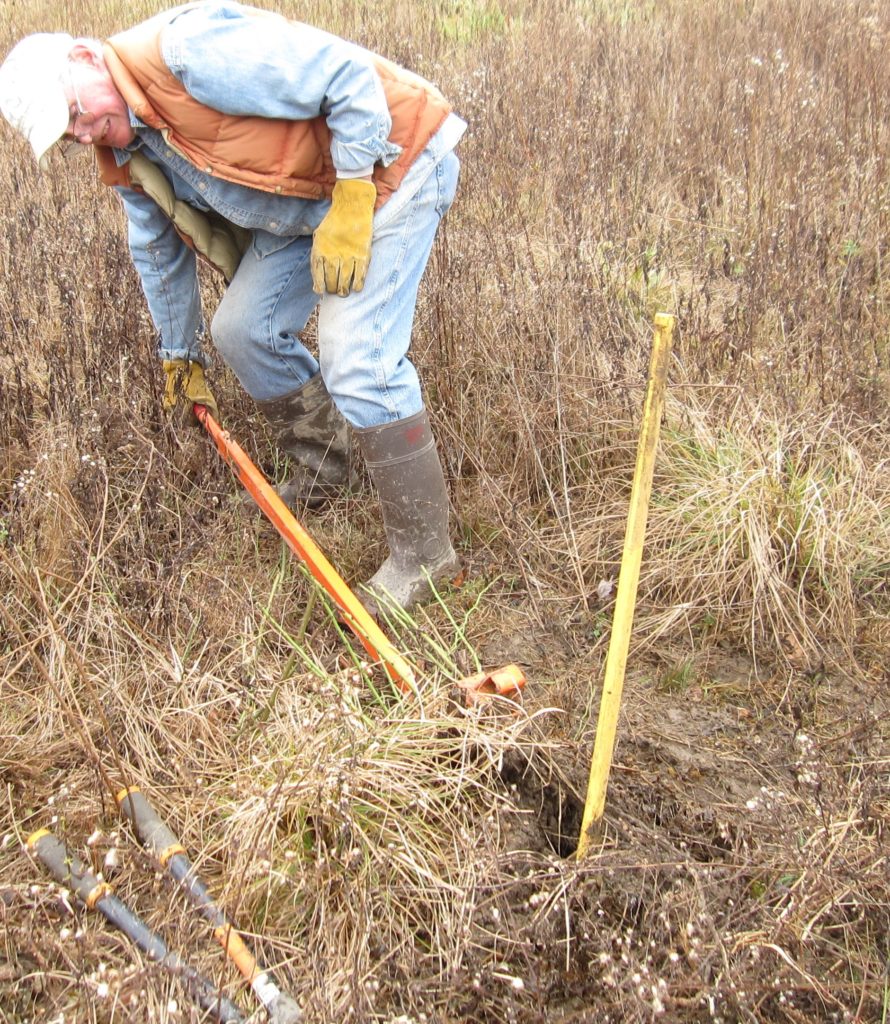 Weed wrench, Pulaski ax and loppers
Weed wrench, Pulaski ax and loppers
Both the weed wrench and the Pulaski pull out the stump with the benefit of leverage.
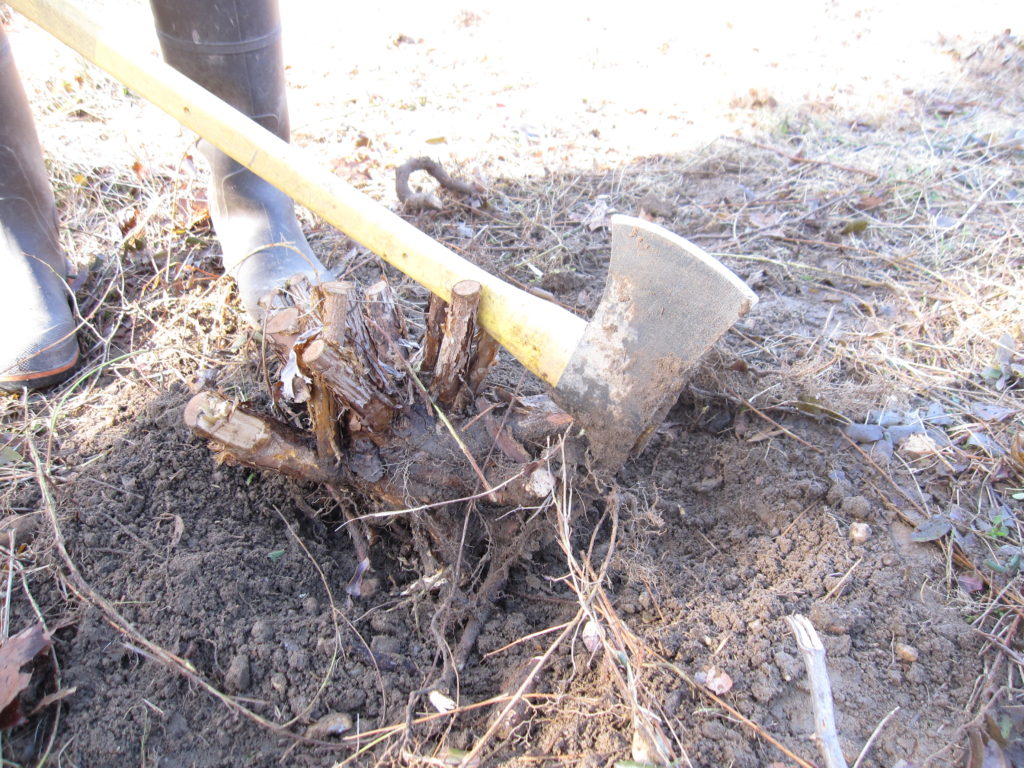 Large multiflora rose root crown and Pulaski ax
Large multiflora rose root crown and Pulaski ax
Larger plants with substantial crowns can be dug out with a mattock tool or a Pulaski landscaping ax, using the curved mattock blade for digging.
 Girdle at the crown with a limb saw
Girdle at the crown with a limb saw
One way to kill a large root crown so the plant dies but remains in place for the time being, is to make a cut or girdle about ½” deep below the stems of the shrub at ground level with a limb saw blade. The canes may be removed once the shrub has died.
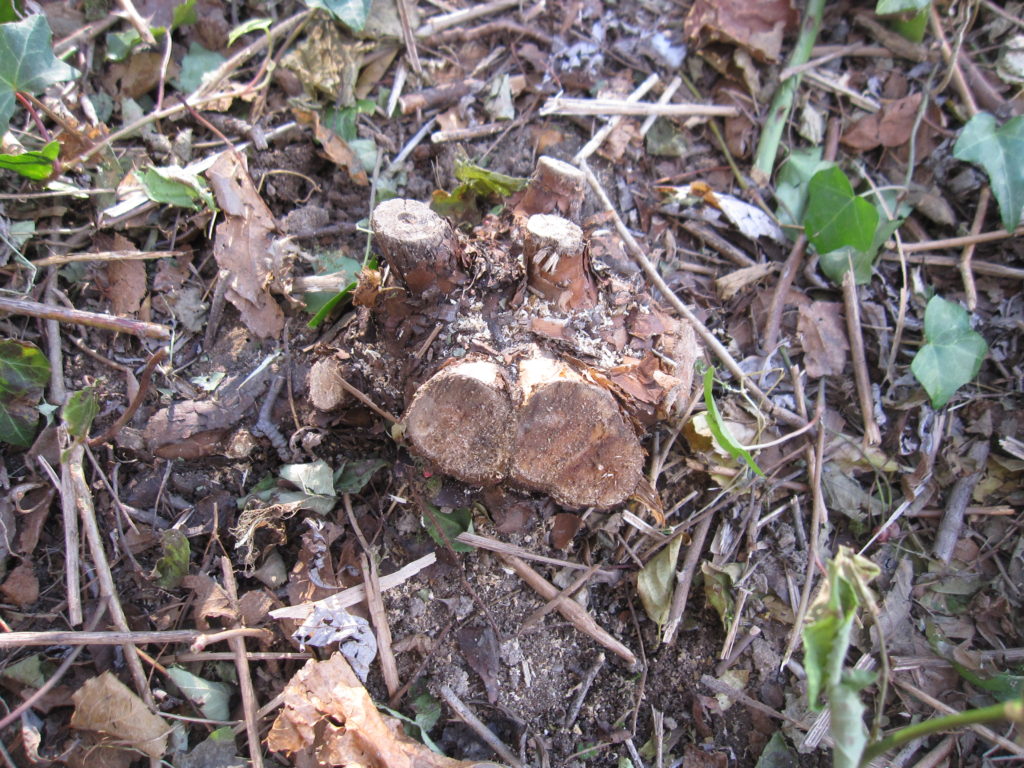 Large multiflora rose above the root crown
Large multiflora rose above the root crown
Then, should uprooting multiflora rose be something to put off for the time being, growth may be inhibited by preventing solar exposure.
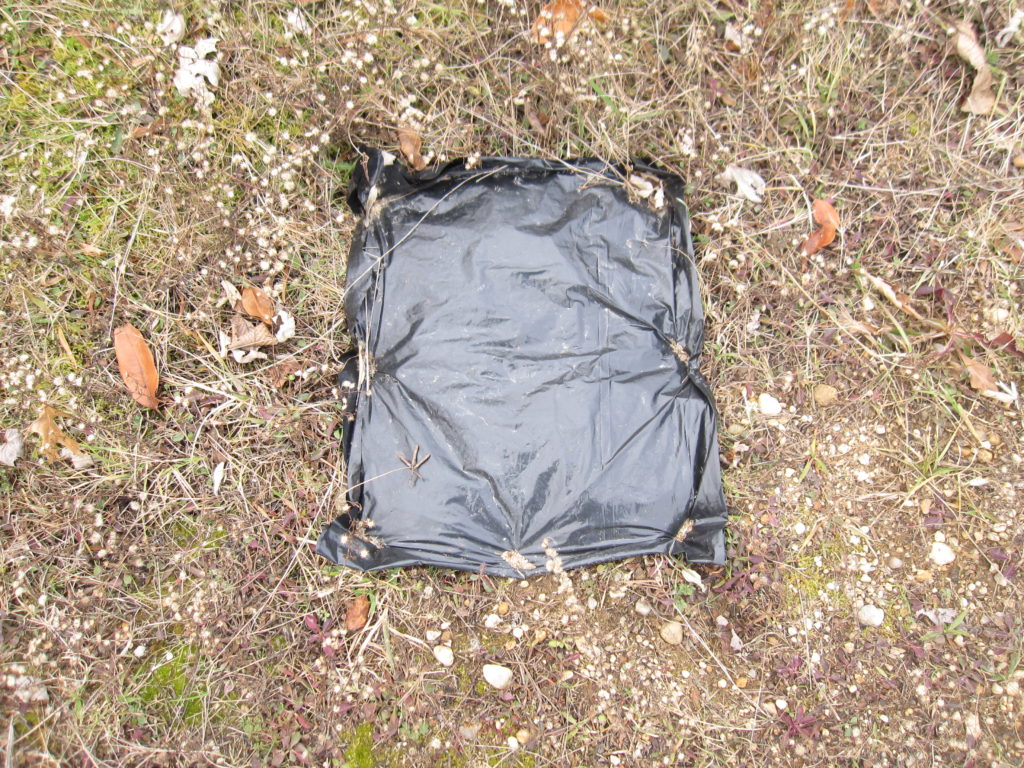 Black plastic sheeting inhibits photosynthesis
Black plastic sheeting inhibits photosynthesis
Simply cut the stems at the ground, then cover the crown that remains in the ground with 2 mil thick black plastic sheeting. Secure this cover with landscape staples and leave in place for one year,
